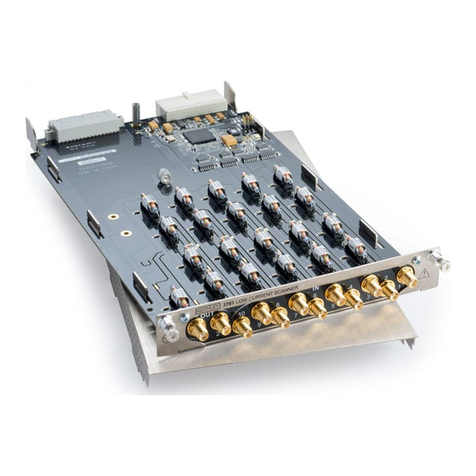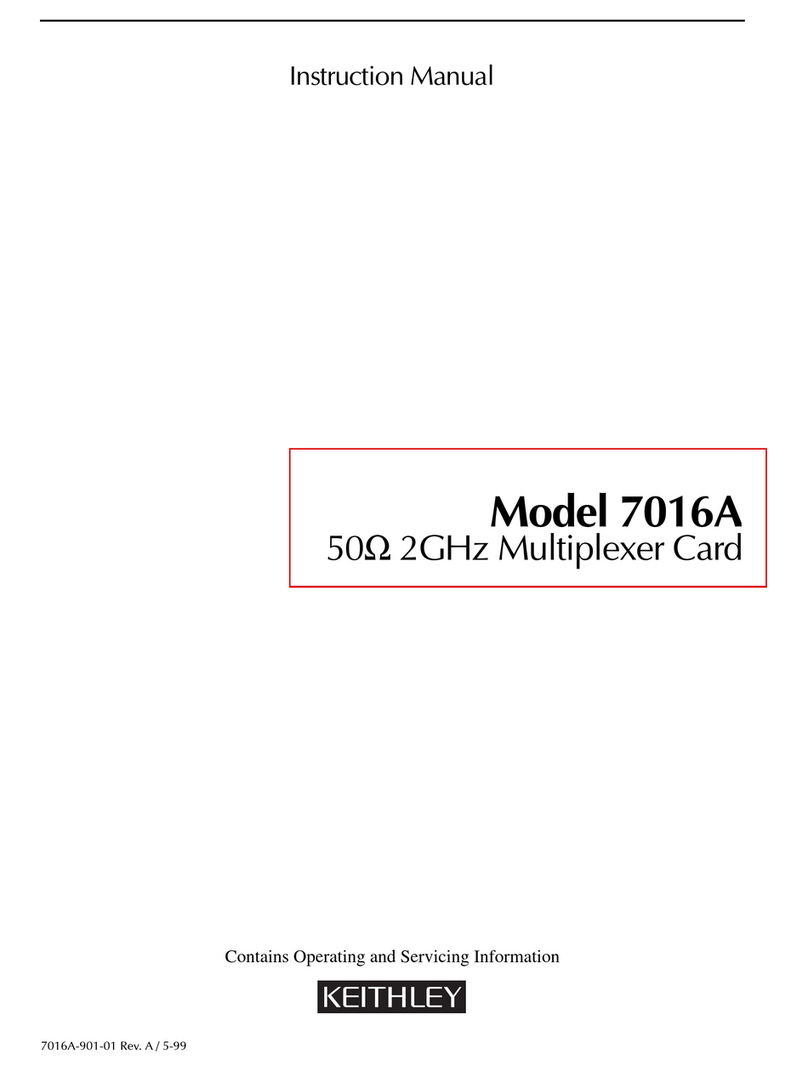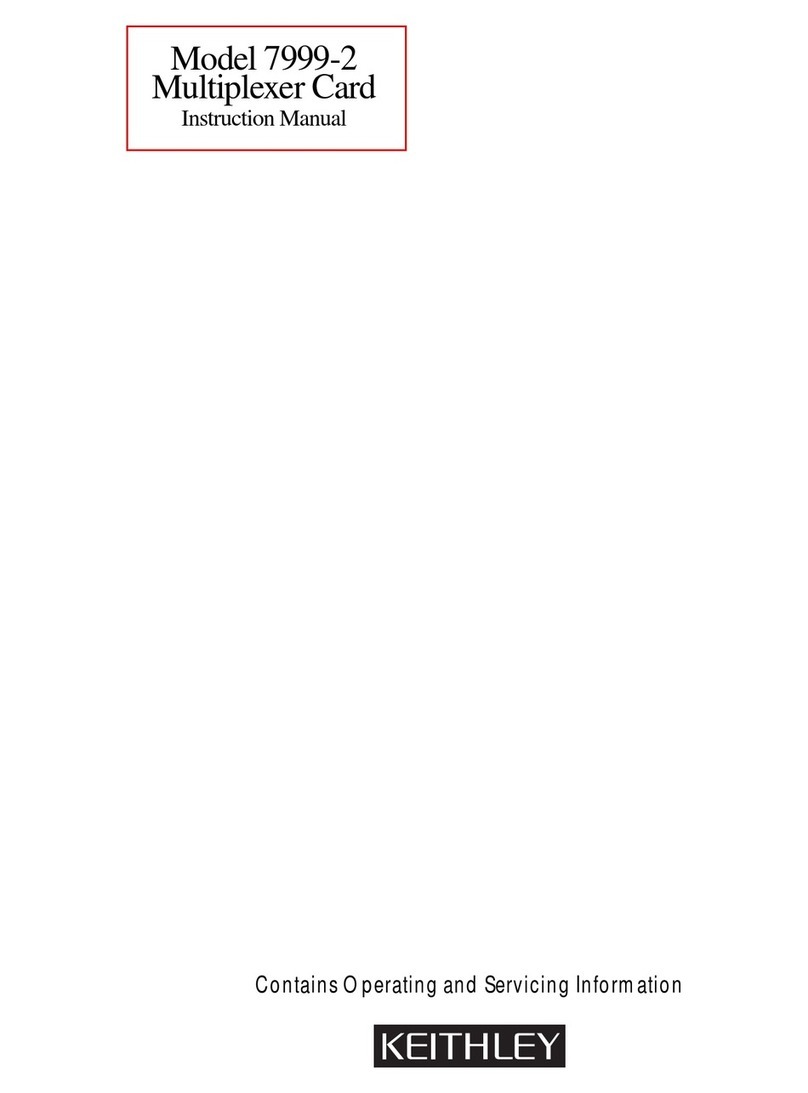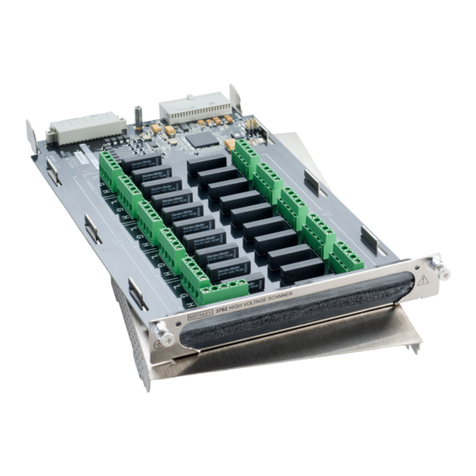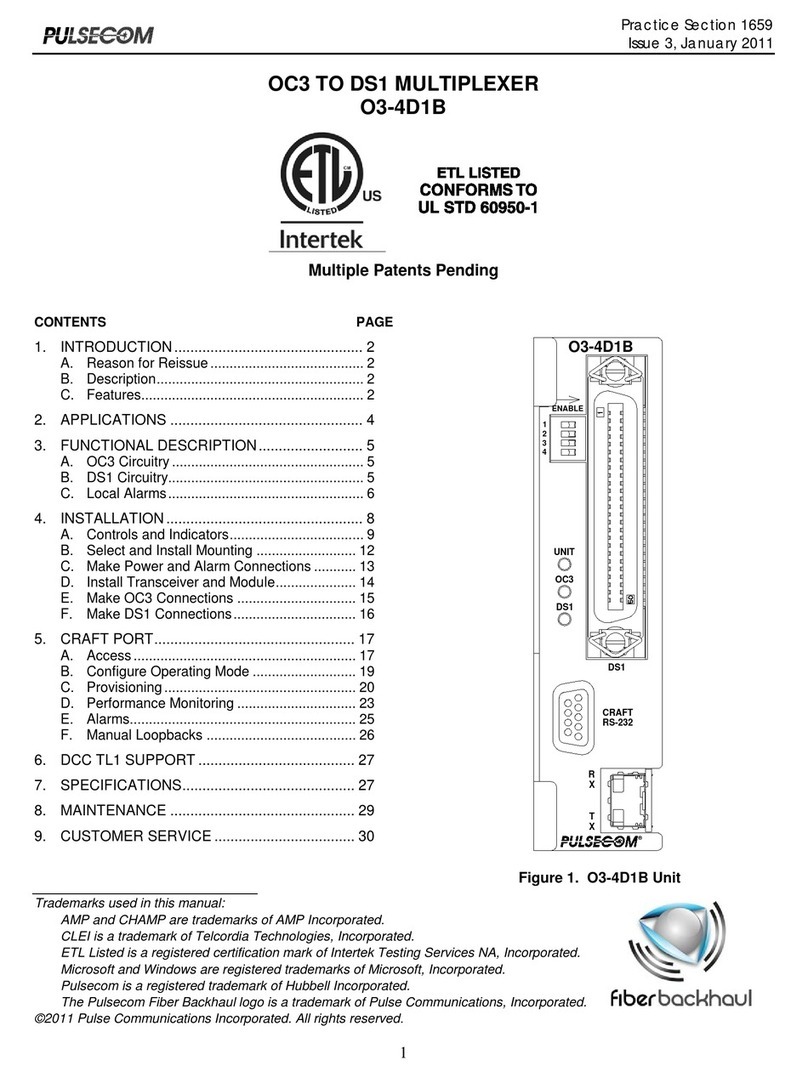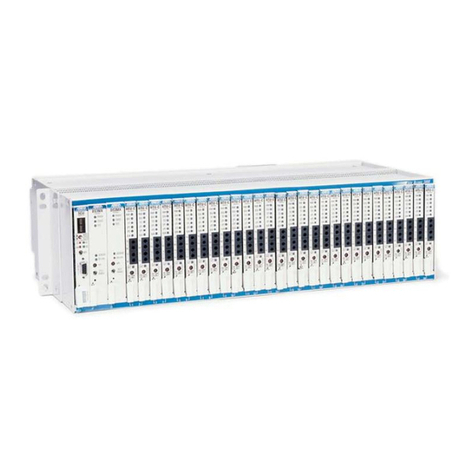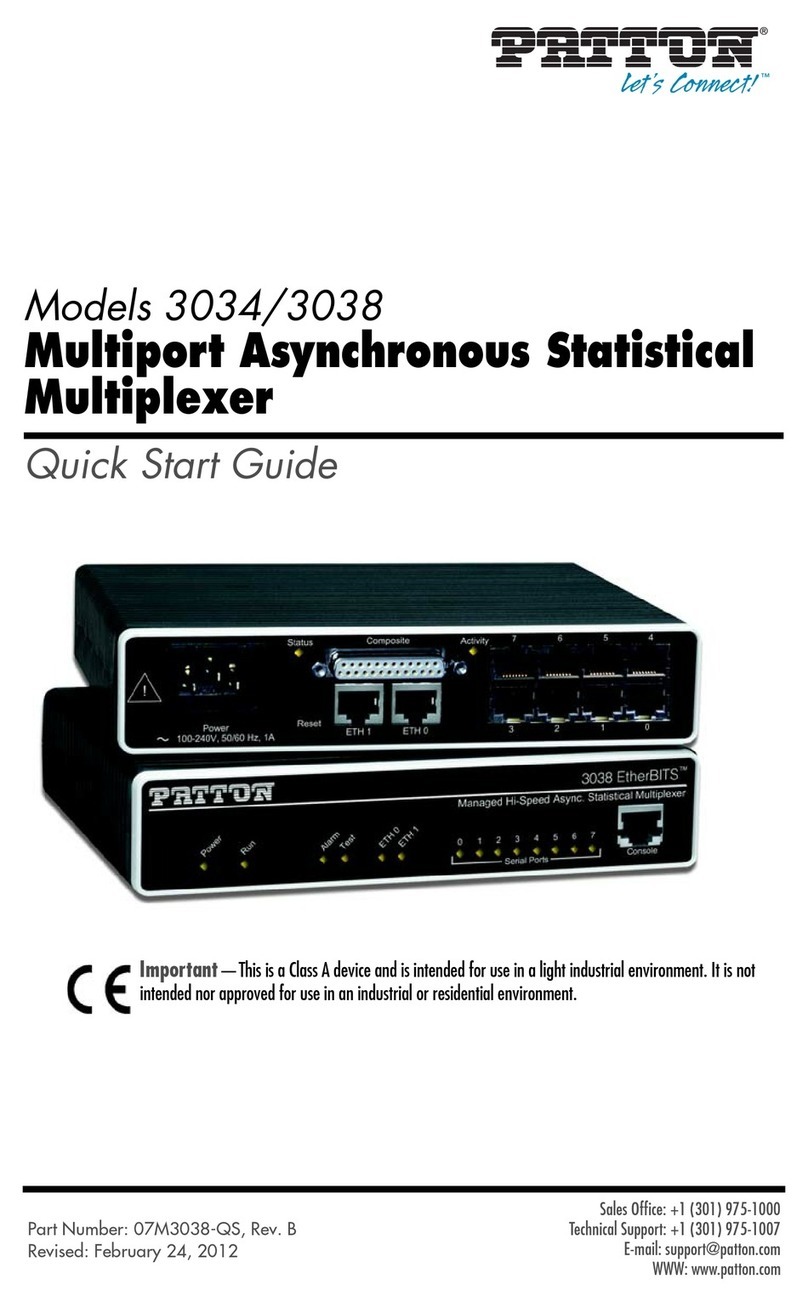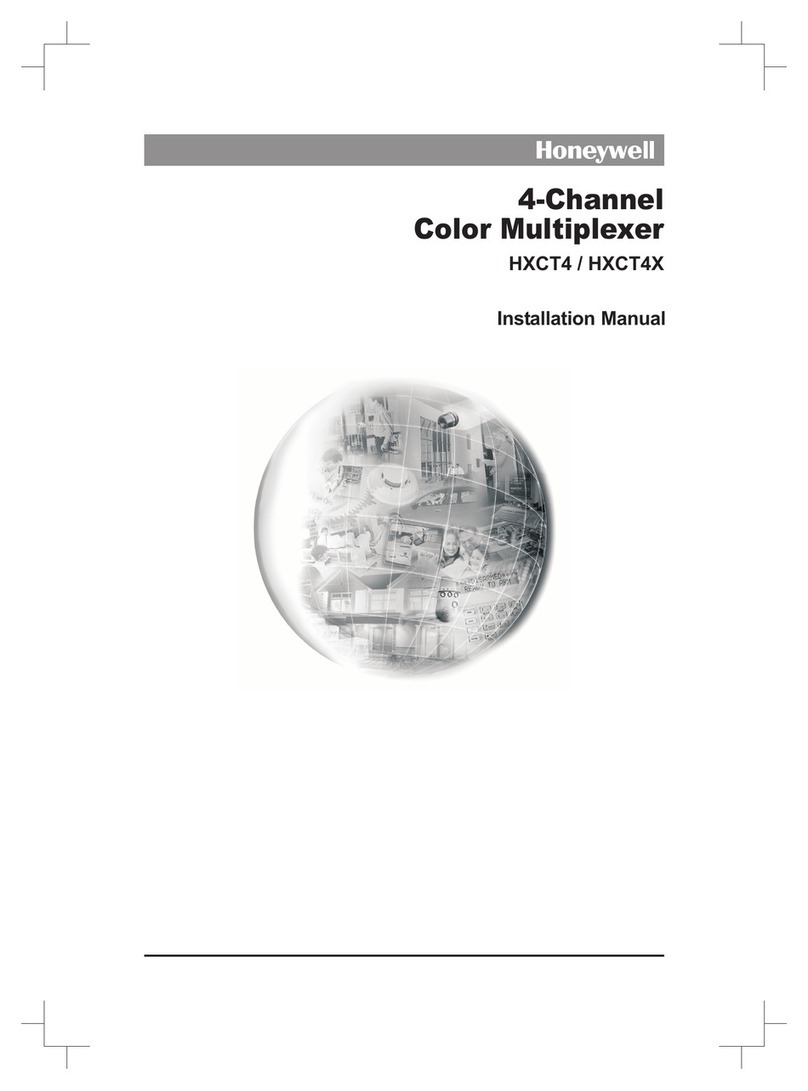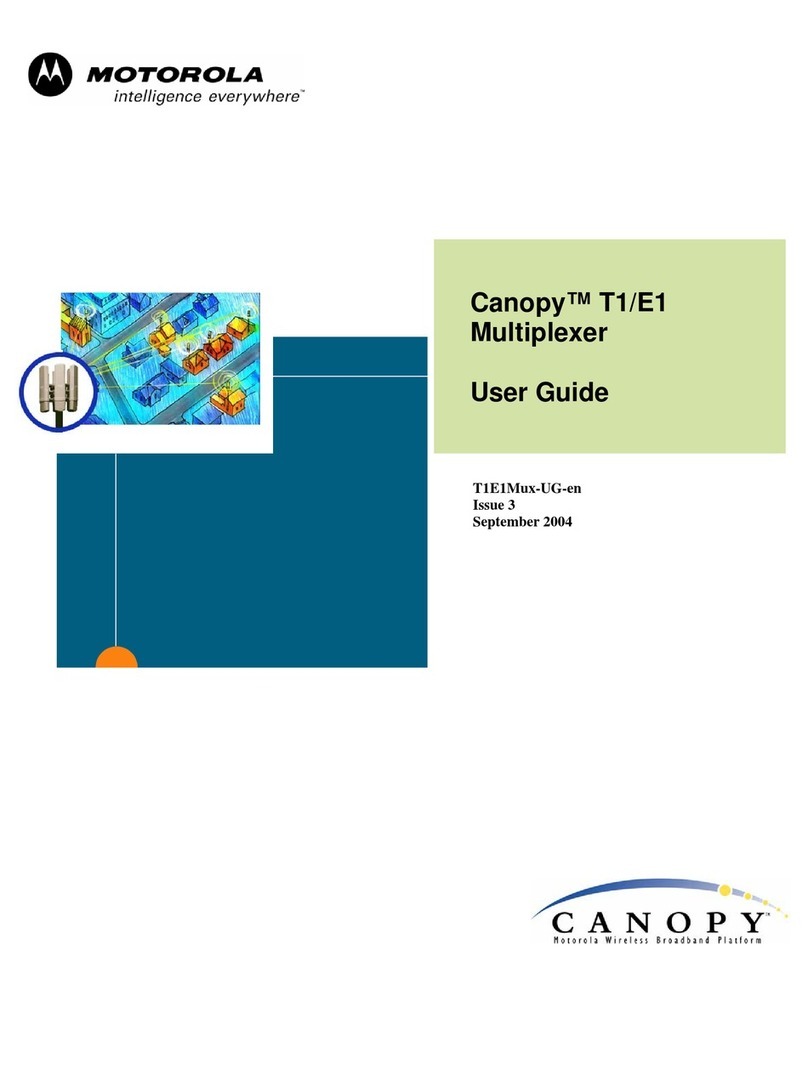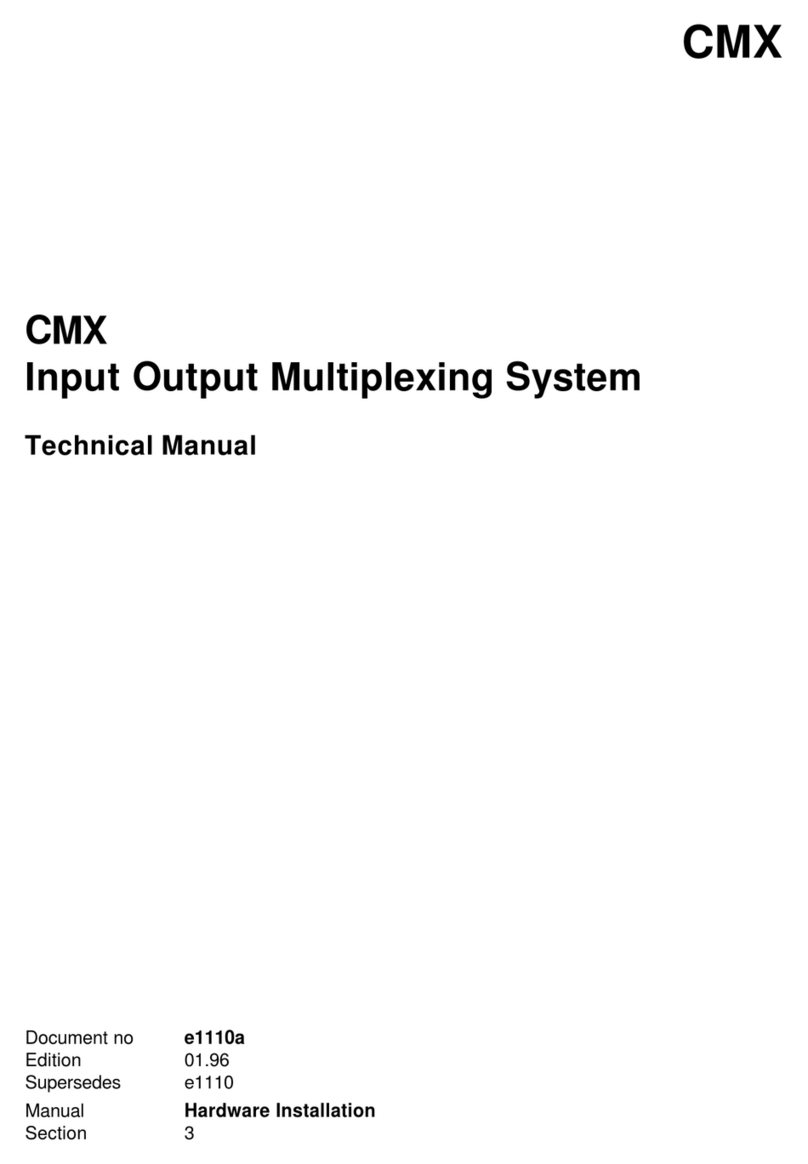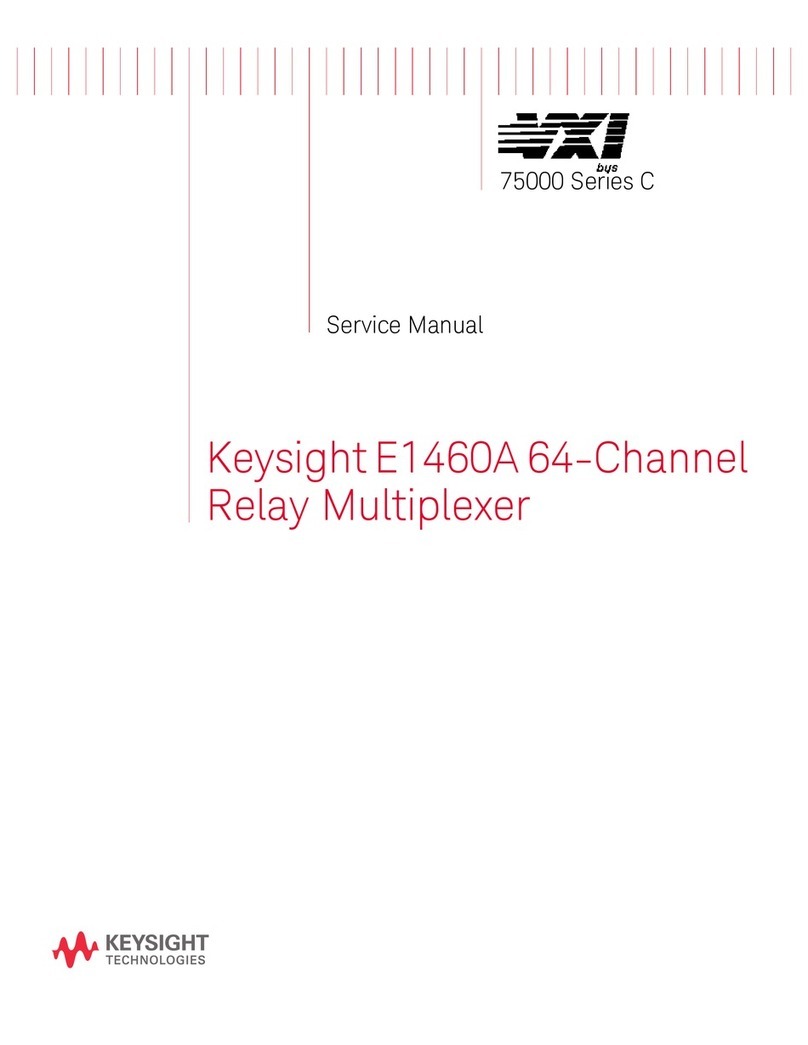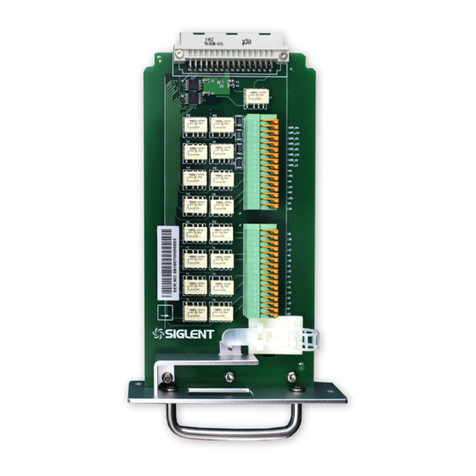Keithley 7074 User manual

WARRANTY
Keithley Instruments, Inc. warrants this product to be free from defects in material and workmanship for a period of 1 year
from date of shipment.
Keithley Instruments, Inc. warrants the following items for 90 days from the date of shipment: probes, cables, rechargeable
batteries, diskettes, and documentation.
During the warranty period, we will, at our option, either repair or replace any product that proves to be defective.
To exercise this warranty, write or call your local Keithley representative, or contact Keithley headquarters in Cleveland, Ohio.
You will be given prompt assistance and return instructions. Send the product, transportation prepaid, to the indicated service
facility. Repairs will be made and the product returned, transportation prepaid. Repaired or replaced products are warranted for
the balance of the original warranty period, or at least 90 days.
LIMITATION OF WARRANTY
This warranty does not apply to defects resulting from product modification without Keithley’s express written consent, or
misuse of any product or part. This warranty also does not apply to fuses, software, non-rechargeable batteries, damage from
battery leakage, or problems arising from normal wear or failure to follow instructions.
THIS WARRANTY IS IN LIEU OF ALL OTHER WARRANTIES, EXPRESSED OR IMPLIED, INCLUDING ANY
IMPLIED WARRANTY OF MERCHANTABILITY OR FITNESS FOR A PARTICULAR USE. THE REMEDIES PRO-
VIDED HEREIN ARE BUYER’S SOLE AND EXCLUSIVE REMEDIES.
NEITHER KEITHLEY INSTRUMENTS, INC. NOR ANY OF ITS EMPLOYEES SHALL BE LIABLE FOR ANY DIRECT,
INDIRECT, SPECIAL, INCIDENTAL OR CONSEQUENTIAL DAMAGES ARISING OUT OF THE USE OF ITS
INSTRUMENTS AND SOFTWARE EVEN IF KEITHLEY INSTRUMENTS, INC., HAS BEEN ADVISED IN ADVANCE
OF THE POSSIBILITY OF SUCH DAMAGES. SUCH EXCLUDED DAMAGES SHALL INCLUDE, BUT ARE NOT LIM-
ITED TO: COSTS OF REMOVAL AND INSTALLATION, LOSSES SUSTAINED AS THE RESULT OF INJURY TO ANY
PERSON, OR DAMAGE TO PROPERTY.
Keithley Instruments, Inc.
• 28775Aurora Road • Cleveland, OH 44139 • 440-248-0400 • Fax: 440-248-6168 • http://www.keithley.com
BELGIUM: Keithley Instruments B.V.
Bergensesteenweg 709 • B-1600 Sint-Pieters-Leeuw • 02/363 00 40 • Fax: 02/363 00 64
CHINA: Keithley Instruments China
Yuan Chen Xin Building, Room 705 • 12Yumin Road, Dewai, Madian • Beijing 100029 • 8610-62022886 • Fax: 8610-62022892
FRANCE: Keithley Instruments Sarl
3, allée des Garays • 91127 Palaiseau Cedex • 01-64 53 20 20 • Fax: 01-60 11 77 26
GERMANY: Keithley Instruments GmbH
Landsberger Strasse 65 • 82110 Germering • 089/84 93 07-40 • Fax: 089/84 93 07-34
GREAT BRITAIN: Keithley Instruments Ltd
The Minster • 58 Portman Road • Reading, Berkshire RG30 1EA • 0118-9 57 56 66 • Fax: 0118-9 59 64 69
INDIA: Keithley Instruments GmbH
Flat 2B, WILOCRISSA • 14, Rest House Crescent • Bangalore 560 001 • 91-80-509-1320/21 • Fax: 91-80-509-1322
ITALY: Keithley Instruments s.r.l.
Viale S. Gimignano, 38 • 20146 Milano • 02-48 39 16 01 • Fax: 02-48 30 22 74
NETHERLANDS: Keithley Instruments B.V.
Postbus 559 • 4200AN Gorinchem • 0183-635333 • Fax: 0183-630821
SWITZERLAND: Keithley Instruments SA
Kriesbachstrasse 4 • 8600 Dübendorf • 01-821 94 44 • Fax: 01-820 30 81
TAIWAN: Keithley Instruments Taiwan
1 Fl. 85 Po Ai Street • Hsinchu, Taiwan, R.O.C. • 886-3572-9077 • Fax: 886-3572-903
9/00

Model 7074 General Purpose Multiplexer Card
Instruction Manual
©1989, Keithley Instruments, Inc.
All rights reserved.
Cleveland, Ohio, U.S.A.
Document Number: 7074-901-01 Rev. B

Manual Print History
The print history shown below lists the printing dates of all Revisions and Addenda created for this manual. The
Revision Level letter increases alphabetically as the manual undergoes subsequent updates. Addenda, which are
released between Revisions, contain important change information that the user should incorporate immediately into
the manual. Addenda are numbered sequentially. When a new Revision is created, all Addenda associated with the
previous Revision of the manual are incorporated into the new Revision of the manual. Each new Revision includes
a revised copy of this print history page.
RevisionA (Document Number 7074-901-01)................................................................................... January 1989
Addendum A (Document Number 7074-901-02)............................................................................. February 1996
Revision B (Document Number 7074-901-01)..................................................................................... March 2001
All Keithley product names are trademarks or registered trademarks of Keithley Instruments, Inc.
Other brand and product names are trademarks or registered trademarks of their respective holders.

Safety Precautions
The following safety precautions should be observed before using
this product and any associated instrumentation.Although some in-
struments and accessories would normally be used with non-haz-
ardous voltages, there are situations where hazardous conditions
may be present.
This product is intended for use by qualified personnel who recog-
nize shock hazards and are familiar with the safety precautions re-
quired to avoid possible injury. Read the operating information
carefully before using the product.
The types of product users are:
Responsible body
is the individual or group responsible for the use
and maintenance of equipment, for ensuring that the equipment is
operated within its specifications and operating limits, and for en-
suring that operators are adequately trained.
Operators
use the product for its intended function. They must be
trained in electrical safety procedures and proper use of the instru-
ment. They must be protected from electric shock and contact with
hazardous live circuits.
Maintenancepersonnel
perform routine procedures on the product
to keep it operating, for example, setting the line voltage or replac-
ing consumable materials. Maintenance procedures are described in
the manual. The procedures explicitly state if the operator may per-
form them. Otherwise, they should be performed only by service
personnel.
Service personnel
are trained to work on live circuits, and perform
safe installations and repairs of products. Only properly trained ser-
vice personnel may perform installation and service procedures.
Keithley products are designed for use with electrical signals that
are rated Installation Category I and Installation Category II, as de-
scribed in the International Electrotechnical Commission (IEC)
Standard IEC 60664. Most measurement, control, and data I/O sig-
nals are Installation Category I and must not be directly connected
to mains voltage or to voltage sources with high transient over-volt-
ages. Installation Category II connections require protection for
high transient over-voltages often associated with local AC mains
connections. The user should assume all measurement, control, and
data I/O connections are for connection to Category I sources un-
less otherwise marked or described in the Manual.
Exercise extreme caution when a shock hazard is present. Lethal
voltage may be present on cable connector jacks or test fixtures.The
American National Standards Institute (ANSI) states that a shock
hazard exists when voltage levels greater than 30V RMS, 42.4V
peak, or 60VDC are present.
A good safety practice is to expect
that hazardous voltage is present in any unknown circuit before
measuring.
Users of this product must be protected from electric shock at all
times. The responsible body must ensure that users are prevented
access and/or insulated from every connection point. In some cases,
connections must be exposed to potential human contact. Product
users in these circumstances must be trained to protect themselves
from the risk of electric shock. If the circuit is capable of operating
at or above 1000 volts,
no conductive part of the circuit may be
exposed.
Do not connect switching cards directly to unlimited power circuits.
They are intended to be used with impedance limited sources.
NEVER connect switching cards directly to AC mains. When con-
necting sources to switching cards, install protective devices to lim-
it fault current and voltage to the card.
Before operating an instrument, make sure the line cord is connect-
ed to a properly grounded power receptacle. Inspect the connecting
cables, test leads, and jumpers for possible wear, cracks, or breaks
before each use.
When installing equipment where access to the main power cord is
restricted, such as rack mounting, a separate main input power dis-
connect device must be provided, in close proximity to the equip-
ment and within easy reach of the operator.
For maximum safety, do not touch the product, test cables, or any
other instruments while power is applied to the circuit under test.
ALWAYS remove power from the entire test system and discharge
any capacitors before: connecting or disconnecting cables or jump-
ers, installing or removing switching cards, or making internal
changes, such as installing or removing jumpers.
Do not touch any object that could provide a current path to the com-
mon side of the circuit under test or power line (earth) ground.Always
make measurements with dry hands while standing on a dry, insulated
surface capable of withstanding the voltage being measured.

The instrument and accessories must be used in accordance with its
specifications and operating instructions or the safety of the equip-
ment may be impaired.
Do not exceed the maximum signal levels of the instruments and ac-
cessories, as defined in the specifications and operating informa-
tion, and as shown on the instrument or test fixture panels, or
switching card.
When fuses are used in a product, replace with same type and rating
for continued protection against fire hazard.
Chassis connections must only be used as shield connections for
measuring circuits, NOT as safety earth ground connections.
If you are using a test fixture, keep the lid closed while power is ap-
plied to the device under test. Safe operation requires the use of a
lid interlock.
If a screw is present, connect it to safety earth ground using the
wire recommended in the user documentation.
The symbol on an instrument indicates that the user should re-
fer to the operating instructions located in the manual.
The symbol on an instrument shows that it can source or mea-
sure 1000 volts or more, including the combined effect of normal
and common mode voltages. Use standard safety precautions to
avoid personal contact with these voltages.
The
WARNING
heading in a manual explains dangers that might
result in personal injury or death.Always read the associated infor-
mation very carefully before performing the indicated procedure.
The
CAUTION
heading in a manual explains hazards that could
damage the instrument. Such damage may invalidate the warranty.
Instrumentation and accessories shall not be connected to humans.
Before performing any maintenance, disconnect the line cord and
all test cables.
To maintain protection from electric shock and fire, replacement
components in mains circuits, including the power transformer, test
leads, and input jacks, must be purchased from Keithley Instru-
ments. Standard fuses, with applicable national safety approvals,
may be used if the rating and type are the same. Other components
that are not safety related may be purchased from other suppliers as
long as they are equivalent to the original component. (Note that se-
lected parts should be purchased only through Keithley Instruments
to maintain accuracy and functionality of the product.) If you are
unsure about the applicability of a replacement component, call a
Keithley Instruments office for information.
To clean an instrument, use a damp cloth or mild, water based
cleaner. Clean the exterior of the instrument only. Do not apply
cleaner directly to the instrument or allow liquids to enter or spill
on the instrument. Products that consist of a circuit board with no
case or chassis (e.g., data acquisition board for installation into a
computer) should never require cleaning if handled according to in-
structions. If the board becomes contaminated and operation is af-
fected, the board should be returned to the factory for proper
cleaning/servicing.
!
2/01

7074-D General Purpose Eight 1xl 2
Multiplexer Card (Dry Reed)
MULTIPLEX CONFIGURATION: Eight 1x12 banks. Adjacent banks can be connected together. Jun
can be removed to isolate any bank from the backplane.
CONTACT CONFIGURATION: 3 pole Form A (HI, LO, GUARD).
CONNECTOR TYPE: Four 75 pin connectors for bank connections, one 38 pin connector for row
connections.
MAXIMUM SIGNAL LEVEL: ZOOV,1A tarry/0.5A switched, 1OVA peak (resistive load).
COMMON MODE VOLTAGE: ZOOVmaximum behveen any 2 pins or chassis.
CONTACT LIFE:
Cold Switching: 108 closures.
At Maximum Signal Level: 105 closures.
CHANNEL RESISTANCE (per conductor): <0.6Q initial, <1.6R at end of contact life.
CONTACT POTENTIAL: <5pV per contact pair (HI to LO, <1 minute after actuation).
OFFSET CURRENT: <lOOpA.
ISOLATION:
Bank: >lOlOQ, <lOpF.
Channel: >lOIOQ <lOpF.
Differential: >109R, 55pF nominal.
Common Mode: >lOgn, 300pF nominal.
CROSSTALK:
Bank: <-55dB at IMHz, 5OQ load.
Channel: c-55dB at IMHz, 5OQ load.
INSERTION LOSS (lMHz, 5OS2source, 5OQ load): O.ldB typical.
3dB BANDWIDTH (50R load): 1OMHz typical.
RELAY DRIVE CURRENT(per relay): 15mA.
RELAY SETTLING TIME: <3msec.
ENVIRONMENT:
Operating: 0” to 5O”C, up to 35°C @ 70% R.H.
Storage: -25” to 65°C.
ACCESSORIES SUPPLIED: Instruction manual, 8 spare backplane jumpers.
ACCESSORIES AVAILABLE:
Bank Connector Accessories:
Model 7074~CITz Contact Extraction Tool
Model 7074HCT: Hand Crimping Tool
Model 7074-m Mass Terminated Plug with Contacts
Model 7074MTC.20: Mass Terminated Cable Assembly, 6m(20 ft.)
Model 7074MTR: Mass Terminated Receptacle with Contacts
Model 7074RTc: Relay Test Shorting Connector
Row Connector Accessories:
Model 7078-CIT: Contact Insertion and Extraction Tools
Model 7078.HCT: Hand Crimping Tool
Model 7078-KIT: Mass Terminated Plug with Contacts
Model 7078~MTC-5: Mass Terminated Cable Assembly, 1.5m (5 ft.)
Model 7078MTC-20: Mass Terminated Cable Assembly, 6x1(20 ft.)
Model 7078MTR: Mass Terminated Receptacle with Contacts
Specifications subject to change without notice.
All specifications applicable to eight 1x12 configuration only.

7074-M General Purpose Eight 1x12
Multiplexer Card (Mercury Wetted Reed)
MULTIPLEX CONFIGURATION: Eight 1x12 banks. Adjacent banks can be connected together.
Jumpers can be removed to isolate any bank from the backplane.
CONTACT CONFIGURATION: 3 pole Form A (HI, LO, GUARD).
CONNECTOR TYPE: Four 75 pin connectors for bank connections, one 38 pin connector for row
connections.
MAXIMUM SIGNAL LEVEL: 2OOV,3A cany/2A switched, SOVA peak (resistive load).
COMMON MODE VOLTAGE: ZOOVmaximum between any 2 pins or chassis.
CONTACT LIFE:
Cold Switching: 109 closures.
At Maximum Signal Level: 108 closures.
CHANNEL RESISTANCE (per conducted: co.60 initial, cO.7Q at end of contact life.
CONTACT POTENTIAL: <IO&V per contact pair (HI to LO, <I minute after actuation).
OFFSET CURRENT: <lOOpA.
ISOLATION:
Bank: >lOl&, <IOpF.
Channel: >lO%-L, <lOpF.
Differential: >I094 55pF nominal.
Common Mode: >lOgQ. 300nF nominal.
.
CROSSTALK:
Bank: <-55dB at IMHz, 5OQ load.
Channel: <-55dB at IMHz, 5On load.
INSERTION LOSS (lMHz, 5OQ source, 5OQ load): O.ldB typical.
3dB BANDWIDTH (5OQ load): 1OMHz typical.
RELAY DRIVE CURRENT(per relay): 5OmA.
RELAY SETTLING TIME: <3msec.
ENVIRONMENT:
Operating: 0” to 5O”C, up to 35°C @ 70% R.H.
Storage: -25 to 65°C.
ACCESSORIES SUPPLIED: Instruction manual, 8 spare backplane jumpers.
ACCESSORIES AVAILABLE:
Bank Connector Accessories:
Model 7074~CIT: Contact Extraction Tool
Model 7074-HCT: Hand Crimping Tool
Model 7074-KIT: Mass Terminated Plug with Contacts
Model 7074-MTC-20: Mass Terminated Cable Assembly, 6m (20 ft.)
Model 7074-MTR: Mass Terminated Receptacle with Contacts
Model 7074-RTC: Relay Test Shorting Connector
Row Connector Accessories:
Model 7078~CIT: Contact Insertion and Extraction Tools
Model 7078-HCT: Hand Crimping Tool
Model 7078-KIT: Mass Terminated Plug with Contacts
Model 7078-MTC-5: Mass Terminated Cable Assembly, 1.511-t(5 ft.)
Model 7078-MTC-20: Mass Terminated Cable Assembly, 6m (20 ft.)
Model 7078-MTR: Mass Terminated Receptacle with Contacts
Specifications subject to change without notice.
All specifications applicable to eight 1x12 configuration only.

HOW TO USE THIS MANUAL
Contains information on Model 7074 features, specifica-
SECTION 1
tions, and accessories.
General Information
Details installation of the Model 7074 General Purpose Mul-
tiplexer Card within the Model 707 Switching Matrix, ccw
ers card signal paths, and describes connections.
SECTION 2
Operation
Gives typical applications for the Model 7074.
SECTION 3
Applications
Contains performance verification procedures, troubleshoot-
ing information, and principles of operation for the multi-
plexer card.
SECTION 4
Service Information
Lists replacement parts, and also includes component layout
and schematic drawings for the Model 7074.
SECTION 5
Replaceable Parts

Table of Contents
SECTION 1 —
General Information
1.1 INTRODUCTION . . . . . . . . . . . . . . . . . . . . . . . . . . . . . . . . . . . . . . . . . . . . . . . . . . . . . . . . . . . . . . . . . . . . 1-1
1.2 FEATURES . . . . . . . . . . . . . . . . . . . . . . . . . . . . . . . . . . . . . . . . . . . . . . . . . . . . . . . . . . . . . . . . . . . . . . . . . . 1-1
1.3 WARRANTY INFORMATION . . . . . . . . . . . . . . . . . . . . . . . . . . . . . . . . . . . . . . . . . . . . . . . . . . . . . . . . . 1-1
1.4 MANUAL ADDENDA . . . . . . . . . . . . . . . . . . . . . . . . . . . . . . . . . . . . . . . . . . . . . . . . . . . . . . . . . . . . . . . . 1-1
1.5 SAFETY SYMBOLS AND TERMS . . . . . . . . . . . . . . . . . . . . . . . . . . . . . . . . . . . . . . . . . . . . . . . . . . . . . . 1-1
1.6 SPECIFICATIONS . . . . . . . . . . . . . . . . . . . . . . . . . . . . . . . . . . . . . . . . . . . . . . . . . . . . . . . . . . . . . . . . . . . . 1-2
1.7 UNPACKING AND INSPECTION . . . . . . . . . . . . . . . . . . . . . . . . . . . . . . . . . . . . . . . . . . . . . . . . . . . . . . 1-2
1.7.1 Inspection for Damage . . . . . . . . . . . . . . . . . . . . . . . . . . . . . . . . . . . . . . . . . . . . . . . . . . . . . . . . . . . . . . 1-2
1.7.2 Shipment Contents . . . . . . . . . . . . . . . . . . . . . . . . . . . . . . . . . . . . . . . . . . . . . . . . . . . . . . . . . . . . . . . . . 1-2
1.7.3 Instruction Manual . . . . . . . . . . . . . . . . . . . . . . . . . . . . . . . . . . . . . . . . . . . . . . . . . . . . . . . . . . . . . . . . . 1-2
1.8 REPACKING FOR SHIPMENT . . . . . . . . . . . . . . . . . . . . . . . . . . . . . . . . . . . . . . . . . . . . . . . . . . . . . . . . . 1-2
1.9 OPTIONAL ACCESSORIES . . . . . . . . . . . . . . . . . . . . . . . . . . . . . . . . . . . . . . . . . . . . . . . . . . . . . . . . . . . . 1-2
1.9.1 BANK Receptacle Accessories . . . . . . . . . . . . . . . . . . . . . . . . . . . . . . . . . . . . . . . . . . . . . . . . . . . . . . . . 1-2
1.9.2 ROW Receptacle Accessories . . . . . . . . . . . . . . . . . . . . . . . . . . . . . . . . . . . . . . . . . . . . . . . . . . . . . . . . . 1-3
SECTION 2 —
Operation
2.1 INTRODUCTION . . . . . . . . . . . . . . . . . . . . . . . . . . . . . . . . . . . . . . . . . . . . . . . . . . . . . . . . . . . . . . . . . . . . 2-1
2.2 HANDLING PRECAUTIONS . . . . . . . . . . . . . . . . . . . . . . . . . . . . . . . . . . . . . . . . . . . . . . . . . . . . . . . . . . 2-1
2.3 ENVIRONMENTAL CONSIDERATIONS . . . . . . . . . . . . . . . . . . . . . . . . . . . . . . . . . . . . . . . . . . . . . . . . 2-1
2.4 MULTIPLEXER CARD CONFIGURATION . . . . . . . . . . . . . . . . . . . . . . . . . . . . . . . . . . . . . . . . . . . . . . 2-1
2.4.1 Rear Panel . . . . . . . . . . . . . . . . . . . . . . . . . . . . . . . . . . . . . . . . . . . . . . . . . . . . . . . . . . . . . . . . . . . . . . . . . 2-1
2.4.2 1
×
12 Multiplexer Banks . . . . . . . . . . . . . . . . . . . . . . . . . . . . . . . . . . . . . . . . . . . . . . . . . . . . . . . . . . . . . 2-2
2.4.3 Multiplexer Bank Jumpers . . . . . . . . . . . . . . . . . . . . . . . . . . . . . . . . . . . . . . . . . . . . . . . . . . . . . . . . . . . 2-2
2.4.4 Backplane Connection Jumpers . . . . . . . . . . . . . . . . . . . . . . . . . . . . . . . . . . . . . . . . . . . . . . . . . . . . . . . 2-7
2.4.5 Switching ConÞgurations . . . . . . . . . . . . . . . . . . . . . . . . . . . . . . . . . . . . . . . . . . . . . . . . . . . . . . . . . . . . 2-7
2.5 CARD INSTALLATION AND REMOVAL . . . . . . . . . . . . . . . . . . . . . . . . . . . . . . . . . . . . . . . . . . . . . . . 2-10
2.6 CONNECTION METHODS . . . . . . . . . . . . . . . . . . . . . . . . . . . . . . . . . . . . . . . . . . . . . . . . . . . . . . . . . . . 2-11
2.6.1 Connection Methods . . . . . . . . . . . . . . . . . . . . . . . . . . . . . . . . . . . . . . . . . . . . . . . . . . . . . . . . . . . . . . . . 2-11
2.6.2 Connection Methods Using Mass Terminated Cables . . . . . . . . . . . . . . . . . . . . . . . . . . . . . . . . . . . . 2-12
2.6.3 Connection Method Using Connector Kits . . . . . . . . . . . . . . . . . . . . . . . . . . . . . . . . . . . . . . . . . . . . . 2-17
2.6.4 Wiring Receptacles (Models 7074-MTR and 7078-MTR) . . . . . . . . . . . . . . . . . . . . . . . . . . . . . . . . . . 2-25
2.7 TYPICAL CONNECTION SCHEMES . . . . . . . . . . . . . . . . . . . . . . . . . . . . . . . . . . . . . . . . . . . . . . . . . . . 2-28
2.7.1 Single Mainframe, Single Multiplexer Card System . . . . . . . . . . . . . . . . . . . . . . . . . . . . . . . . . . . . . 2-28
2.7.2 Expanding the Multiplexer Using Multiple Cards . . . . . . . . . . . . . . . . . . . . . . . . . . . . . . . . . . . . . . . 2-29
2.7.3 Using the Multiplexer with Matrix Cards . . . . . . . . . . . . . . . . . . . . . . . . . . . . . . . . . . . . . . . . . . . . . . 2-29
2.8 MULTIPLEXER PROGRAMMING . . . . . . . . . . . . . . . . . . . . . . . . . . . . . . . . . . . . . . . . . . . . . . . . . . . . . . 2-33
2.8.1 Banks and Rows . . . . . . . . . . . . . . . . . . . . . . . . . . . . . . . . . . . . . . . . . . . . . . . . . . . . . . . . . . . . . . . . . . . . 2-33
2.8.2 Front Panel Multiplexer Programming Procedure . . . . . . . . . . . . . . . . . . . . . . . . . . . . . . . . . . . . . . . 2-33
2.8.3 IEEE-488 Bus Programming . . . . . . . . . . . . . . . . . . . . . . . . . . . . . . . . . . . . . . . . . . . . . . . . . . . . . . . . . . 2-33

2.9 MEASUREMENT CONSIDERATIONS . . . . . . . . . . . . . . . . . . . . . . . . . . . . . . . . . . . . . . . . . . . . . . . . . . 2-34
2.9.1 Path Isolation . . . . . . . . . . . . . . . . . . . . . . . . . . . . . . . . . . . . . . . . . . . . . . . . . . . . . . . . . . . . . . . . . . . . . . 2-34
2.9.2 Magnetic Fields . . . . . . . . . . . . . . . . . . . . . . . . . . . . . . . . . . . . . . . . . . . . . . . . . . . . . . . . . . . . . . . . . . . . 2-35
2.9.3 Electromagnetic Interference (EMI) . . . . . . . . . . . . . . . . . . . . . . . . . . . . . . . . . . . . . . . . . . . . . . . . . . . 2-35
2.9.4 Ground Loops . . . . . . . . . . . . . . . . . . . . . . . . . . . . . . . . . . . . . . . . . . . . . . . . . . . . . . . . . . . . . . . . . . . . . 2-35
2.9.5 Keeping Connectors Clean . . . . . . . . . . . . . . . . . . . . . . . . . . . . . . . . . . . . . . . . . . . . . . . . . . . . . . . . . . . 2-36
2.9.6 Shielding . . . . . . . . . . . . . . . . . . . . . . . . . . . . . . . . . . . . . . . . . . . . . . . . . . . . . . . . . . . . . . . . . . . . . . . . . . 2-36
2.9.7 Guarding . . . . . . . . . . . . . . . . . . . . . . . . . . . . . . . . . . . . . . . . . . . . . . . . . . . . . . . . . . . . . . . . . . . . . . . . . . 2-36
2.9.8 Multiple Card Considerations . . . . . . . . . . . . . . . . . . . . . . . . . . . . . . . . . . . . . . . . . . . . . . . . . . . . . . . . 2-37
2.9.9 AC Frequency Response . . . . . . . . . . . . . . . . . . . . . . . . . . . . . . . . . . . . . . . . . . . . . . . . . . . . . . . . . . . . . 2-37
SECTION 3 —
Applications
3.1 INTRODUCTION . . . . . . . . . . . . . . . . . . . . . . . . . . . . . . . . . . . . . . . . . . . . . . . . . . . . . . . . . . . . . . . . . . . . 3-1
3.2 RESISTOR TESTING . . . . . . . . . . . . . . . . . . . . . . . . . . . . . . . . . . . . . . . . . . . . . . . . . . . . . . . . . . . . . . . . . 3-1
3.2.1 2-Wire Resistance Tests . . . . . . . . . . . . . . . . . . . . . . . . . . . . . . . . . . . . . . . . . . . . . . . . . . . . . . . . . . . . . . 3-1
3.2.2 4-Wire Resistance Tests . . . . . . . . . . . . . . . . . . . . . . . . . . . . . . . . . . . . . . . . . . . . . . . . . . . . . . . . . . . . . . 3-2
3.2.3 Low-Level Resistance Measurements . . . . . . . . . . . . . . . . . . . . . . . . . . . . . . . . . . . . . . . . . . . . . . . . . 3-3
3.2.4 Example Resistor Test Program . . . . . . . . . . . . . . . . . . . . . . . . . . . . . . . . . . . . . . . . . . . . . . . . . . . . . . . 3-4
3.3 TRANSISTOR TESTING. . . . . . . . . . . . . . . . . . . . . . . . . . . . . . . . . . . . . . . . . . . . . . . . . . . . . . . . . . . . . . . 3-4
3.3.1 Current Gain Tests . . . . . . . . . . . . . . . . . . . . . . . . . . . . . . . . . . . . . . . . . . . . . . . . . . . . . . . . . . . . . . . . . . 3-4
3.3.2 Common-Emitter Characteristics Tests . . . . . . . . . . . . . . . . . . . . . . . . . . . . . . . . . . . . . . . . . . . . . . . . 3-6
3.3.3 Example Transistor Test Program . . . . . . . . . . . . . . . . . . . . . . . . . . . . . . . . . . . . . . . . . . . . . . . . . . . . . 3-6
3.4 TESTING WITH MATRIX CARDS . . . . . . . . . . . . . . . . . . . . . . . . . . . . . . . . . . . . . . . . . . . . . . . . . . . . . . 3-7
3.4.1 Multiplexer and Matrix Card Connections . . . . . . . . . . . . . . . . . . . . . . . . . . . . . . . . . . . . . . . . . . . . . 3-7
3.4.2 Resistivity Tests . . . . . . . . . . . . . . . . . . . . . . . . . . . . . . . . . . . . . . . . . . . . . . . . . . . . . . . . . . . . . . . . . . . . 3-7
3.4.3 Example Resistivity Test Program . . . . . . . . . . . . . . . . . . . . . . . . . . . . . . . . . . . . . . . . . . . . . . . . . . . . 3-10
SECTION 4 —
Service Information
4.1 INTRODUCTION . . . . . . . . . . . . . . . . . . . . . . . . . . . . . . . . . . . . . . . . . . . . . . . . . . . . . . . . . . . . . . . . . . . . 4-1
4.2 HANDLING AND CLEANING PRECAUTIONS . . . . . . . . . . . . . . . . . . . . . . . . . . . . . . . . . . . . . . . . . 4-1
4.3 RELAY TEST PROGRAM SETUP . . . . . . . . . . . . . . . . . . . . . . . . . . . . . . . . . . . . . . . . . . . . . . . . . . . . . . . 4-1
4.3.1 Recommended Equipment . . . . . . . . . . . . . . . . . . . . . . . . . . . . . . . . . . . . . . . . . . . . . . . . . . . . . . . . . . . 4-2
4.3.2 Connections . . . . . . . . . . . . . . . . . . . . . . . . . . . . . . . . . . . . . . . . . . . . . . . . . . . . . . . . . . . . . . . . . . . . . . . 4-2
4.3.3 Running the Test . . . . . . . . . . . . . . . . . . . . . . . . . . . . . . . . . . . . . . . . . . . . . . . . . . . . . . . . . . . . . . . . . . . 4-2
4.4 PERFORMANCE VERIFICATION . . . . . . . . . . . . . . . . . . . . . . . . . . . . . . . . . . . . . . . . . . . . . . . . . . . . . . 4-2
4.4.1 Environmental Conditions . . . . . . . . . . . . . . . . . . . . . . . . . . . . . . . . . . . . . . . . . . . . . . . . . . . . . . . . . . . 4-3
4.4.2 Recommended Test Equipment . . . . . . . . . . . . . . . . . . . . . . . . . . . . . . . . . . . . . . . . . . . . . . . . . . . . . . . 4-3
4.4.3 Performance Record . . . . . . . . . . . . . . . . . . . . . . . . . . . . . . . . . . . . . . . . . . . . . . . . . . . . . . . . . . . . . . . . 4-4
4.4.4 Initial Preparation . . . . . . . . . . . . . . . . . . . . . . . . . . . . . . . . . . . . . . . . . . . . . . . . . . . . . . . . . . . . . . . . . . 4-4
4.4.5 Path Resistance Tests . . . . . . . . . . . . . . . . . . . . . . . . . . . . . . . . . . . . . . . . . . . . . . . . . . . . . . . . . . . . . . . . 4-5
4.4.6 Offset Current Tests . . . . . . . . . . . . . . . . . . . . . . . . . . . . . . . . . . . . . . . . . . . . . . . . . . . . . . . . . . . . . . . . . 4-9
4.4.7 Contact Potential Tests . . . . . . . . . . . . . . . . . . . . . . . . . . . . . . . . . . . . . . . . . . . . . . . . . . . . . . . . . . . . . . 4-10
4.4.8 Path Isolation Tests . . . . . . . . . . . . . . . . . . . . . . . . . . . . . . . . . . . . . . . . . . . . . . . . . . . . . . . . . . . . . . . . . 4-11
4.4.9 Differential and Common Mode Isolation Tests . . . . . . . . . . . . . . . . . . . . . . . . . . . . . . . . . . . . . . . . . 4-12
4.5 SPECIAL HANDLING OF STATIC-SENSITIVE DEVICES . . . . . . . . . . . . . . . . . . . . . . . . . . . . . . . . . 4-16

4.6 DISASSEMBLY . . . . . . . . . . . . . . . . . . . . . . . . . . . . . . . . . . . . . . . . . . . . . . . . . . . . . . . . . . . . . . . . . . . . . . . 4-16
4.6.1 Disassembly . . . . . . . . . . . . . . . . . . . . . . . . . . . . . . . . . . . . . . . . . . . . . . . . . . . . . . . . . . . . . . . . . . . . . . . 4-16
4.6.2 Rear Shield Removal and Replacement . . . . . . . . . . . . . . . . . . . . . . . . . . . . . . . . . . . . . . . . . . . . . . . . 4-17
4.7 TROUBLESHOOTING . . . . . . . . . . . . . . . . . . . . . . . . . . . . . . . . . . . . . . . . . . . . . . . . . . . . . . . . . . . . . . . . 4-17
4.7.1 Recommended Equipment . . . . . . . . . . . . . . . . . . . . . . . . . . . . . . . . . . . . . . . . . . . . . . . . . . . . . . . . . . . 4-17
4.7.2 Using the Extender Card . . . . . . . . . . . . . . . . . . . . . . . . . . . . . . . . . . . . . . . . . . . . . . . . . . . . . . . . . . . . 4-17
4.7.3 Input/Output Connections . . . . . . . . . . . . . . . . . . . . . . . . . . . . . . . . . . . . . . . . . . . . . . . . . . . . . . . . . . 4-18
4.7.4 Troubleshooting Procedure . . . . . . . . . . . . . . . . . . . . . . . . . . . . . . . . . . . . . . . . . . . . . . . . . . . . . . . . . . 4-18
4.7.5 Relay Replacement Precautions . . . . . . . . . . . . . . . . . . . . . . . . . . . . . . . . . . . . . . . . . . . . . . . . . . . . . . . 4-19
4.8 PRINCIPLES OF OPERATION . . . . . . . . . . . . . . . . . . . . . . . . . . . . . . . . . . . . . . . . . . . . . . . . . . . . . . . . . 4-19
4.8.1 Block Diagram . . . . . . . . . . . . . . . . . . . . . . . . . . . . . . . . . . . . . . . . . . . . . . . . . . . . . . . . . . . . . . . . . . . . . 4-19
4.8.2 ID Data Circuits . . . . . . . . . . . . . . . . . . . . . . . . . . . . . . . . . . . . . . . . . . . . . . . . . . . . . . . . . . . . . . . . . . . . 4-20
4.8.3 Relay Control . . . . . . . . . . . . . . . . . . . . . . . . . . . . . . . . . . . . . . . . . . . . . . . . . . . . . . . . . . . . . . . . . . . . . . 4-20
4.8.4 Power-on Safeguard . . . . . . . . . . . . . . . . . . . . . . . . . . . . . . . . . . . . . . . . . . . . . . . . . . . . . . . . . . . . . . . . 4-21
SECTION 5 —
Replaceable Parts
5.1 INTRODUCTION . . . . . . . . . . . . . . . . . . . . . . . . . . . . . . . . . . . . . . . . . . . . . . . . . . . . . . . . . . . . . . . . . . . . 5-1
5.2 PARTS LISTS . . . . . . . . . . . . . . . . . . . . . . . . . . . . . . . . . . . . . . . . . . . . . . . . . . . . . . . . . . . . . . . . . . . . . . . . 5-1
5.3 ORDERING INFORMATION . . . . . . . . . . . . . . . . . . . . . . . . . . . . . . . . . . . . . . . . . . . . . . . . . . . . . . . . . . 5-1
5.4 FACTORY SERVICE . . . . . . . . . . . . . . . . . . . . . . . . . . . . . . . . . . . . . . . . . . . . . . . . . . . . . . . . . . . . . . . . . . 5-1
5.5 COMPONENT LAYOUT AND SCHEMATIC DIAGRAM . . . . . . . . . . . . . . . . . . . . . . . . . . . . . . . . . . 5-1

List Of Illustrations
SECTION 2 - Operation
Figure 2-l
Figure 2-2
Figure 2-3
Figure 2-4
Figure 2-5
Figure 2-6
Figure 2-7
Figure 2-8
Figure 2-9
Figure 2-10
Figure 2-l 1
Figure 2-12
Figure 2-13
Figure 2-14
Figure 2-15
Figure Z-16
Figure 2-17
Figure 2-18
Figure 2-19
Figure 2-20
Figure 2-21
Figure 2-22
Figure 2-23
Figure 2-24
Figure 2-25
Figure 2-26
Figure 2-27
Figure 2-28
Figure 2-29
Figure 2-30
Figure 2-31
Figure 2-32
Figure 2-33
Figure 2-34
Figure 2-35
Figure 2-36
Figure 2-37
Figure 2-38
Model 7074 Rear Panel ..............................
Model 7074 Multiplexer Organization (Factory Configuration)
Model 7074 Card Showing Jumper Locations ............
Eight 1 x 12 Multiplexer Configured (No jumpers installed)
Four 1 x 24 Multiplexer Configuration .................
Two 1 x 48 Multiplexer Configuration .................
1 x 96 Multiplexer Configuration ......................................
Model 7074 Multiplexers Connected to Model 7071 Rows using Backplane Jumpers
Guarded Switching ................................................
Unguarded Switching .............................
4.Wire DMM Switching ...........................
SMU Connections .................................
Model 7074 Installation .............................
Connections Using Mass Terminated Cables .............
Connecting 75-I% Plug to Bank Receptacle ..............
Connecting 38.Pin Plug to ROW Receptacle .............
Connecting Method using MTC Cables Cut in Half ........
Cable Preparation ................................
38-I% Plug Cable Position .........................
38-I% Plug (7078-KIT) Wire Color Coding .............
75-I+ Disassembly ...............................
75-l% Plug Cable Positions .........................
75-I% Plug (7074-KIT) Wire Color Colding .............
Model 7078Xit (ROW A-H) Plug Contact Assignments ....
Model 7074~KIT (Bank) Plug Contact Assignments .......
Bank Receptacle Connector (Wiring side view)
ROW A-H Receptacle Connector
Single Card System Example ........................
Multiple Card System Example ......................
Using the Multiplexer with a Model 7071 Matrix Card .....
Using the Multiplexer with a Model 7071-4 .............
Path Isolation Resistance ...........................
Voltage Attenuation by Path Isolation Resistance ........
Power Line Ground Loops .........................
Eliminating Ground Loops .........................
Shielding Example
Guarded Circuit
Typical Guarded Signal Connections ...
2-2
2-3
2-4
2-5
2-5
2-6
2-6
2-7
2-8
2-8
2-9
2-9
Z-10
2-13
2-14
2-14
2-15
2-18
2-18
2-19
2-20
2-21
2-22
2-23
2-24
2-26
2-27
2-28
Z-30
2-31
2-32
2-34
2-34
2-35
2-36
2-36
2-37
2-38

Figure 2-39 AC Frequency Response Test Configuration 2-38
Figure Z-40 Model 7074 Frequency Response (RL = lMQ, 1 x 96 Configuration) 2-39
Figure 2-41 Model 7074 Frequency Response (RL = 50Q 1 x 96 Configuration 2-40
Figure 242 Model 7074 Frequency Response (Rr = 504 Eight 1 x 12 Configuration 2-41
Figure 243 Model 7074 Frequency Response (RL = 5OQ Eight 1 x 12 Configuration 242
:SECTION 3 - Applications
Figure 3-l 2-Wire Resistance Testing .................................. 3-1
Figure 3-2 4-Wire Resistance Testing .................................. 3-2
Figure 3-3 Low Resistance Testing .................................... 3-3
Figure 3-4 Configuration for Current Gain and Common-Emitter Tests ........ 3-5
Figure 3-5 Typical Common-Emitter Characteristics ...................... 3-6
Figure 3-6 Connecting Multiplexer and Matrix Cards Together .............. 3-7
Figure 3-7 Resistivity Test Configurations .............................. 3-8
Figure 3-8 Measurement Required for Resistivity Test ..................... 3-9
SECTION 4 - Service Information
Figure 4-l
Figure 4-2
Figure 4-3
Figure 4-4
Figure 4-5
Figure 4-6
Figure 4-7
Figure 4-8
Figure 4-9
Figure 4-10
Figure 4-11
Figure 4-12
Figure 4-13
Figure 4-14
Figure 4-15
Figure 4-16
Test Cable Preparation .....................................................
Connecting the Test Cable to the Model 7074 .....................................
Connecting Test Leads to Receptacle ...........................................
ROW A-H Receptacle Contact Assignments (Rear Panel View) .......................
Bank Receptacle Assignments (Rear Panel View) ..................................
Connections for Path Resistance Test ...........................................
Differential Offset Current Test Connections .....................................
Common Mode Offset Current Test Connections ..................................
Contact Potential Test Connections ............................................
Path Isolation Test Connections ..............................................
Differential Isolation Test Connections .........................................
Connections for Common Mode Isolation Tests ...................................
Card Disassembly .........................................................
RearShieldLocation .......................................................
IDDataTiming ...........................................................
Model7074BlockDiagram.. ................................................
4-2
4-3
4-5
4-6
4-7
4-8
4-9
4-10
4-l 1
4-12
4-14
4-15
4-16
4-17
4-19
4-20

List of Tables
SECTION 2 - Operation
Table 2-l Cables, Receptacles, and Special Tools ..............
Table 2-2 Model 7074-MTC Cable Color Codes ...............
Table 2-3 Model 7078.MTC Cable Color Codes ...............
SECTION 4 - Service Information
Table 4-l Recommended Verification Equipment .............
Table 4-2 Performance Record ...........................
Table 4-3 Path Isolation Test Summary .....................
Table 4-4 Differential and Common Mode Isolation Test Summary
Table 4-5 Recommended Troubleshooting Equipment .........
Table 4-6 Troubleshooting Procedure ......................
...........
...........
...........
...........
...........
...........
...........
2-12
2-16
2-17
4-4
4-5
4-13
4-15
4-1s
4-18

SECTION 1
General Information
1.l INTRODUCTION
This section contains general information about the
Model 7074.
Section 1 is arranged in the following manner:
1.2 Feafures
1.3 Warranty Information
1.4 Manual Addenda
1.5 Safety Symbols and Terms
1.6 Specifications
1.7 Unpacking and Inspection
1.8 Repacking for Shipment
1.9 Optional Accessories
1.2 FEATURES
The Model 7074 General Purpose Multiplexer Card con-
sists of eight banks of 1x 12 multiplexers that can be con-
figured in various combinations. Three-pole switching
(HI, LO, guard) is provided for any of the 96 inputs.
The Model 7074 is available with either dry or mercury-
wetted reed relays. The dry-reed version (Model 7074-D)
has lower thermal offset performance, while the mer-
cury-wetted version (Model 7074-M) offers minimal con-
tact bounce for and constant contact resistance overlife.
Throughout this manual, Model 7074 is used to refer to
both versions unless otherwise indicated.
Key features of the Model 7074 include:
Easy jumper configuration of single, dual, quad, or oc-
tal multiplexer banks.
Each of the eight multiplexer banks can be connected
to the 3-p& general-purpose backplane pathways
with user-installed jumpers, allowing simple internal
connections to the rows of those matrix cards.
Five mass-termination receptacles located on the rear
panel for quick-disconnect input and output connec-
tions.
1.3 WARRANTY INFORMATION
Warranty information is located on the inside front cover
of this instruction manual. Should your Model 7074 re-
quire warranty service, contact the Keithley representa-
tive or authorized repair facility in your area for further
information. When returning the card for repair, be sure
to fill out and include the service form at the back of this
manual in order to provide the repair facility with the
necessary information.
1.4 MANUAL ADDENDA
Any improvements or changes concerning the multi-
plexer card or manual will be explained in an addendum
included with the the unit. Be sure to note these changes
and incorporate them into the manual before using or
servicing the card.
1.5 SAFETY SYMBOLS AND TERMS
The following symbols and terms may be found on an in-
strument or used in this manual.
The A symbol on an instrument indicates that the
user should refer to the operating instructions located in
the instruction manual.
The symbol on an instrument shows that 1kV or
greater may be present on the terminal(s). Use standard
1-l

SECTION I
General Information
safety precautions to avoid personal contact with these
voltages.
The WARNING heading used in this manual explains
dangers that might result in personal injury or death. Al-
ways read the associated information very carefully be-
fore performing the indicated procedure.
The CAUTION heading used in this manual explains
hazards which could damage the multiplexer card. Such
damage may invalidate the warranty.
1.6 SPECIFICATIONS
Model 7074-D and Model 7074-M specifications may be
found at the front of this manual. Note that some specifi-
cations, such as contact life, path resistance, and contact
potential, differ between the two versions of the card.
These specifications are exclusive of the matrix main-
frame specifications, which are located in the Model 707
Instruction Manual.
1.7 UNPACKING AND INSPECTION
1.7.1 Inspection for Damage
Upon receiving the Model 7074, carefully unpack it from
its shipping carton and inspect the card for any obvious
signs of physical damage. Report any such damage to the
shipping agent immediately. Save the original packing
carton for possible future reshipment.
1.7.2 Shipment Contents
The following items are included with every Model 7074
order:
. Model 7074-D or 7074-M Multiplexer Card
l Model 7074 Instruction Manual
l Eight spare configuration jumpers
l Additional accessories as ordered
1.7.3 Instruction Manual
The Model 7074 Instruction Manual is three-hole drilled
so that it can be added to the three-ring binder of the
Model 707 Switching Matrix Instruction Manual. After
1-2
removing the plastic wrapping, place the manual in the
binder after the mainframe instruction manual. Note that
a manual identification tab is included and should pre-
cede the multiplexer card instruction manual.
If an additional instruction manual is required, order the
manual package, Keithley part number 7074-901-00. The
manual package includes an instruction manual and any
pertinent addenda.
1.8 REPACKING FOR SHIPMENT
Should it become necessary to return the Model 7074 for
repair, carefully pack the unit in its original packing car-
ton or the equivalent, and include the following~informa-
tion:
Advise as to the warranty status of the multiplexer
card.
Write ATTENTION REPAIR DEPARTMENT on the
shipping label.
Fill out and include the service form located a’ttheback
of this manual.
1.9 OPTIONAL ACCESSORIES
The following paragraphs discuss optional cables, con-
necting kits, and special tools that are available for use
with the Model 7074.
1.9.1 BANK Receptacle Accessories
The following accessories are designed for use with the
four BANK receptacles.
Model 7074-CIT Contact Extraction Tool -The Model
7074~CR includes a tool that is used to remove wire
crimp tail contacts from 75-pin “rack and panel” plugs
and receptacles.
Model 7074-HCT Hand Crimping Tool - The Model
7074-HCT is used to attach wire crimp tail contacts (for
75-pin connectors) to #l&3 to #26 AWG stranded wire.
However, provided contacts should only be used with
#20 to #24 AWG wire.
Model 7074-KIT Connector Kit-The Model 7074~KIT
contains the parts to assemble one 75pin “rack and

SECTION1
General Information
panel” plug. This plug will mate to the BANK receptacle
on the rear panel of the card. Parts contained in the kit in-
clude the plug, 80 wire crimp tail contacts (for use with
#20 to #24 AWG wire), four corner pins, one tunable
male jackscrew, one tunable female jackscrew, and one
shield.
Model 7074-MTC-20 Mass Terminated Cable Assem-
bly - The Model 7074~MTC-20 is a 20-foot (6-meters),
72-conductor cable terminated with a “rack and panel”
plug on both ends. This cable connects to the the BANK
receptacles on the rear panel of the card. This cable can be
cut in half to provide two separate cables, each of which
can be connected to one of the BANK receptacles. The un-
terminated ends of the cables are then connected to in-
strumentation and DUTs.
Model 7074-MTR Mass Terminated Receptacle with
Contacts-The Model 7074~MTR includes a 75-pin con-
nector, 80 crimp tail contacts, (for #20 to #24AWG wire),
one fixed female jackscrew, one fixed male jackscrew,
and four corner pins. The Model 7074-MTR mates with
the Model 7074MTC cables and the Model 7074-KIT
plug kit.
Model 7074-RTC Relay Test Shorting Plug - The
Model 7074-RTC is intended for use with the relay test
software, as described in paragraph 4.2. The Model
7074-RTC consists of a 75-pin plug with pins and jumper
wires.
1.9.2 ROW Receptacle Accessories
The following accessories are intended for use with the
ROW A-H receptacle.
Model 707%CIT Contact Insertion and Extraction Tools
-The Model 7078~CIT includes an insertion tool that is
used to insert wire crimp tail contacts into 38-pin “rack
and panel” plugs and receptacles. Conversely, the extrac-
tion tool is required for the removal of the contacts.
Model 707%HCT Hand Crimping Tool - The Model
707%HCT is used to attach wire crimp tail contacts to #18
to #26 AWG stranded wire.
Model 7078-KIT Connector Kit-The Model 707%KIT
contains the parts to assemble one 38-pin “rack and
panel” plug. This plug will mate to the ROW A-H recep-
tacle on the rear panel of the card. Parts contained in the
kit include the plug, plug housing and 40 wire crimp tail
contacts.
Model 707%MTC-5 Mass Terminated Cable Assembly
-The Model 7078MTC is a 5-foot (1.5~meters), 36-con-
ductor cable terminated with a “rack and panel” plug on
both ends. This cable connects to ROW A-H receptacle on
the rear panel of the card. This cable can be cut in half to
provide two separate cables when using two or more
Model 7074 cards. The unterminated ends of the cables
are then connected to instrumentation and DUTs.
Model 707%MTC-20 Mass Terminated Cable Assem-
bly - Thii cable is the same as the Model 707%MTC-5,
except that it is 20.feet (6-m&& in length.
Model 707%MTR Mass Terminated Receptacle with
Contacts-The Model 707%MTR includes a 3%pin con-
nector and 40 crimp tail contacts. The Model 707%MTR
mates with the Model 7078-MTC cables and the Model
7078-KIT plug kit.
l-3

SECTION 2
Operation
2.1 INTRODUCTION
This section contains information on multiplexer con-
figuration, card connections, installation, and program-
ming, and is arranged as follows:
2.2 Handling Precautions: Discusses precautions that
should be taken when handling the card to avoid con-
tamination that could degrade performance.
2.3 Environmental Considerations: Outlines environ-
mental aspects of using the Model 7074.
2.4 Multiplexer Card Configuration: Discusses the mul-
tiplexer rear panel as well as multiplexer configuration,
and expansion by jumpering two or more multiplexer
sections together.
2.5 Card Installation and Removal: Details installation
in and removal from the Model 707 Switching Matrix
mainframe.
2.6 Connection Methods: Discusses card connectors, ca-
bles, and ways to connect the card to other instruments
and test fixtures.
2.7 Typical Connection Schemes: Gives typical connec-
tions to other cards, mainframes, and test instrumenta-
tion.
2.8 Multiplexer Programming: Summarizes program-
ming steps to control the multiplexer card from the
Model 707 Switching Matrix.
2.9 Measurement Considerations: Reviews a number of
considerations when making measurements using the
Model 7074.
WARNING
The information in this section is intended
for qualified personnel who have experience
with potentially hazardous voltages. Do not
attempt to perfolm these procedures unless
you are qualified to do so. Carefully read the
safety precautions located at the front of this
manual before using the multiplexer card.
2.2 HANDLING PRECAUTIONS
To maintain high impedance isolation, care should be
taken when handling the multiplexer card to avoid con-
tamination from such foreign materials asbody oils. Such
contamination can substantially lower leakage resis-
tances, degrading performance. To avoid any possible
contamination, always grasp the card by the handle or
the card edges. Do not touch board surfaces, compo-
nents, or edge connectors.
Dirt build-up over a period of time is another possible
source of contamination. To avoid this problem, operate
the mainframe and matrix card only in a clean environ-
ment. If contamination is suspected, clean the card asdis-
cussed in Section 4. Also, the performance verification
procedures in Section 4 can be used to test the card for
low leakage resistances that could indicate contamina-
tion.
2.3 ENVIRONMENTAL CONSIDERATIONS
For rated performance, the card should be operated
within the temper&w and humidity limits given in the
specifications at the front of this manual.
2.4 MULTIPLEXER CARD CONFIGURA-
TION
The following paragraphs discuss the rear panel of the
card, the eight 1 x 12 multiplexers of the Model 7074, as
well as how to connect two or moremultiplexer banks to-
gether to make multiplexers as large as 1 x 96.
2.4.1 Rear Panel
The rear panel of the Model 7074 is shown in Figure 2-1.
The rear panel has a total of five receptacles for input/
2-1

SECTION2
Operation
output connections. The four BANK connectors (148,J49,
J51, and J52) would normally be used for multiplexer in-
puts and are labeled with multiplexer bank letters
(BANKS A and B appear on J48, BANKS C and D are on
J49, BANKS E and F are on J51, and BANKS G and H ap-
pear on J52). The eight multiplexer bank outputs are lo-
cated on the ROW A-H connector (JSO).Detailed connec-
tion information can be found in paragraphs 2.6 and 2.7.
2.4.2 1 x 12 Multiplexer Banks
As shown in Figure 2-2, the Model 7074 is organized as
eight 1 x 12 multiplexer banks. These multiplexer banks
are labeled rows A through H in order to conform to
Model 707 Switching Matrix commands.Throughout this
manual, the terms “banks” and “rows” are used inter-
changeably.
The inputs for each row are labeled 1 through 12 inclu-
sive, and these numbers correspond to mainframe col-
umns. Note that 3-p& switching is provided for each
multiplexer input, with HI, LO, and guard switched. Two
or more banks canbe jumpered together to expand multi-
plexer inputs, as discussed below. Note that inputs are
also referred to as channels in this manual.
2.4.3 Multiplexer Bank Jumpers
Jumpers can be installed on the card in order to connect
multiplexer banks together to form multiplexers as large
as 1 x 96. To connect adjacent multiplexer banks, simply
install the jumpers between the adjacent bank jumper
pins, which are shown in Figure 2-3. These jumpers are
included with the Model 7074, but they are not installed
at the factory. Note that you should install the jumpers
for all three signal paths (HI, LO, and guard).
By installing the jumpers in the appropriate places, you
can configure the multiplexer card in a variety of ways.
Typical examples include:
l Eight 1 x 12 multiplexers: no jumpers installed
(Figure 2-4).
l Four 1 x 24 multiplexers: jumper A to B, C to D, E to F,
G to H (Figure 2-5).
l Two 1 x 48 multiplexers: jumper all except D to E
(Figure 2-6).
l One 1 x 96 multiplexer: install all bank jumpers
(Figure 2-7).
2-2
Figure 2-l. Model 7074 Rear hnel
1
Many other combinations are possible, including multi-
plexers of various sizes (in multiples of 12 channels) by
installing jumpers as required. For example, you could
install jumpers to configure the card as two 1 x 24 multi-
plexers and one 1 x 48 multiplexer.
This manual suits for next models
2
Table of contents
Other Keithley Multiplexer manuals
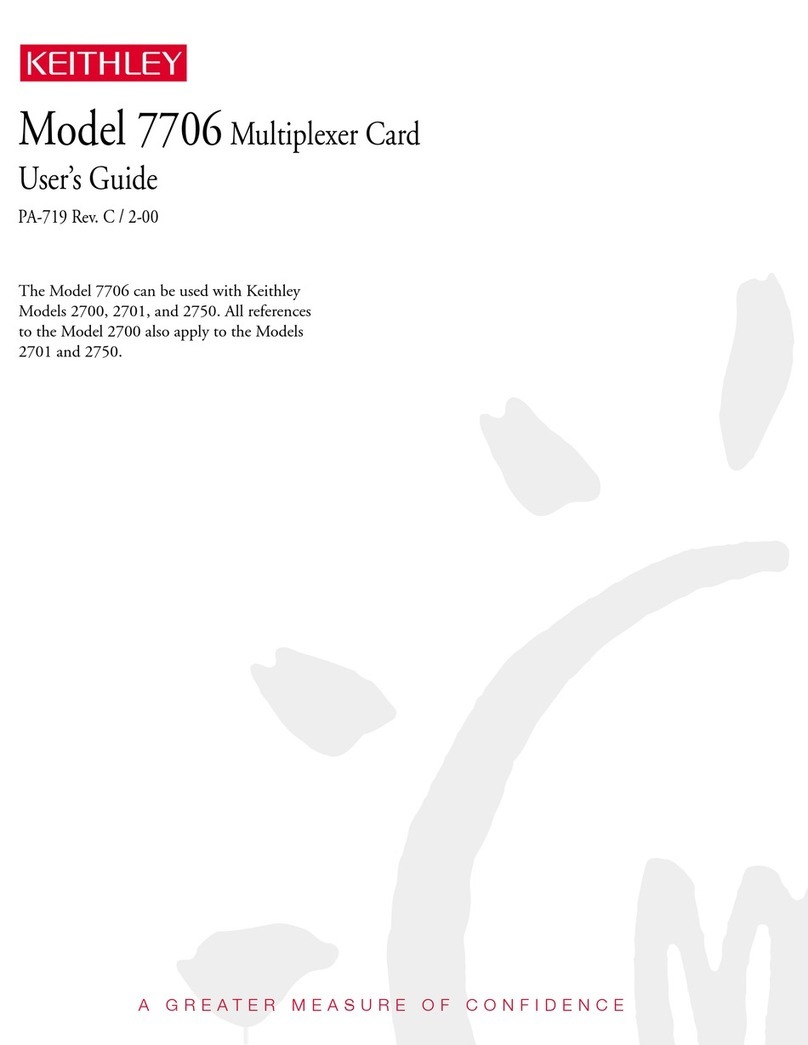
Keithley
Keithley 7706 User manual
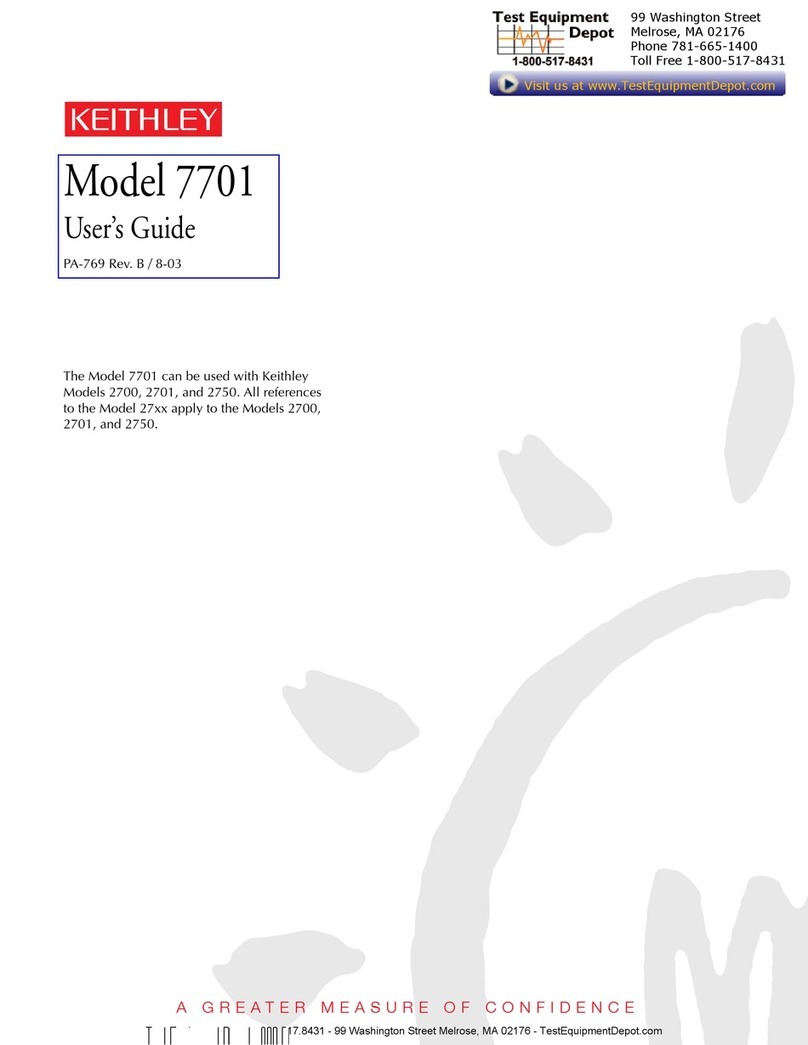
Keithley
Keithley 7701 User manual
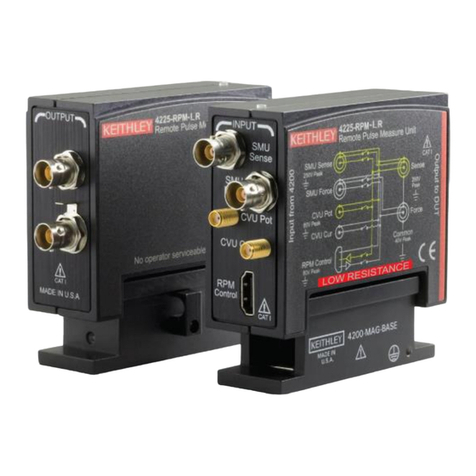
Keithley
Keithley 4225-RPM User manual

Keithley
Keithley 7711 User manual

Keithley
Keithley 7702 User manual
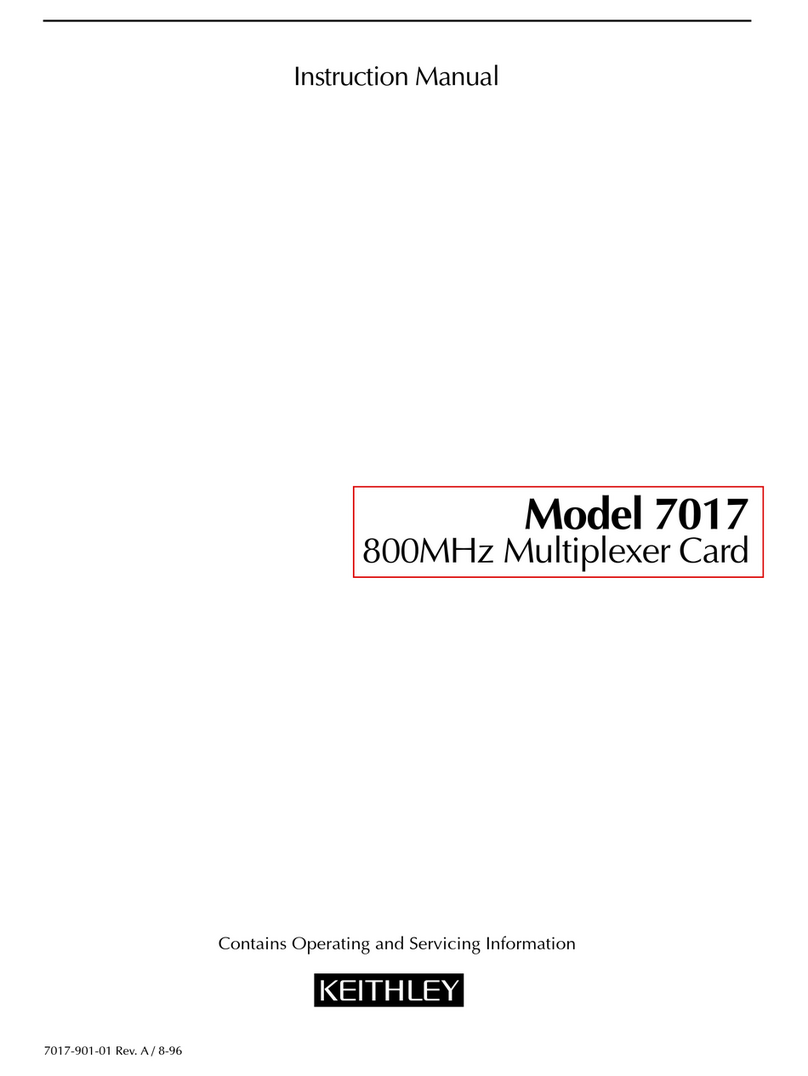
Keithley
Keithley 7017 User manual

Keithley
Keithley 7710 User manual

Keithley
Keithley EXP-16 User manual

Keithley
Keithley 7708 User manual

Keithley
Keithley 7014 User manual
Popular Multiplexer manuals by other brands
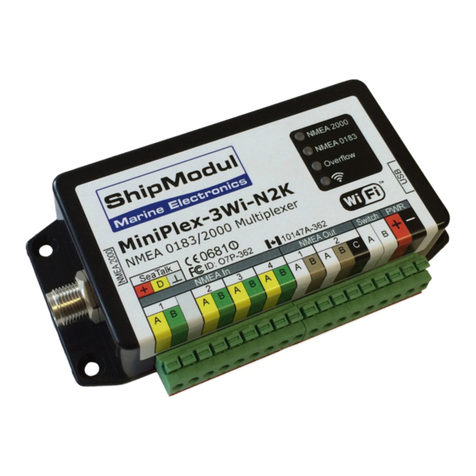
ShipModul
ShipModul MiniPlex-3 Series manual
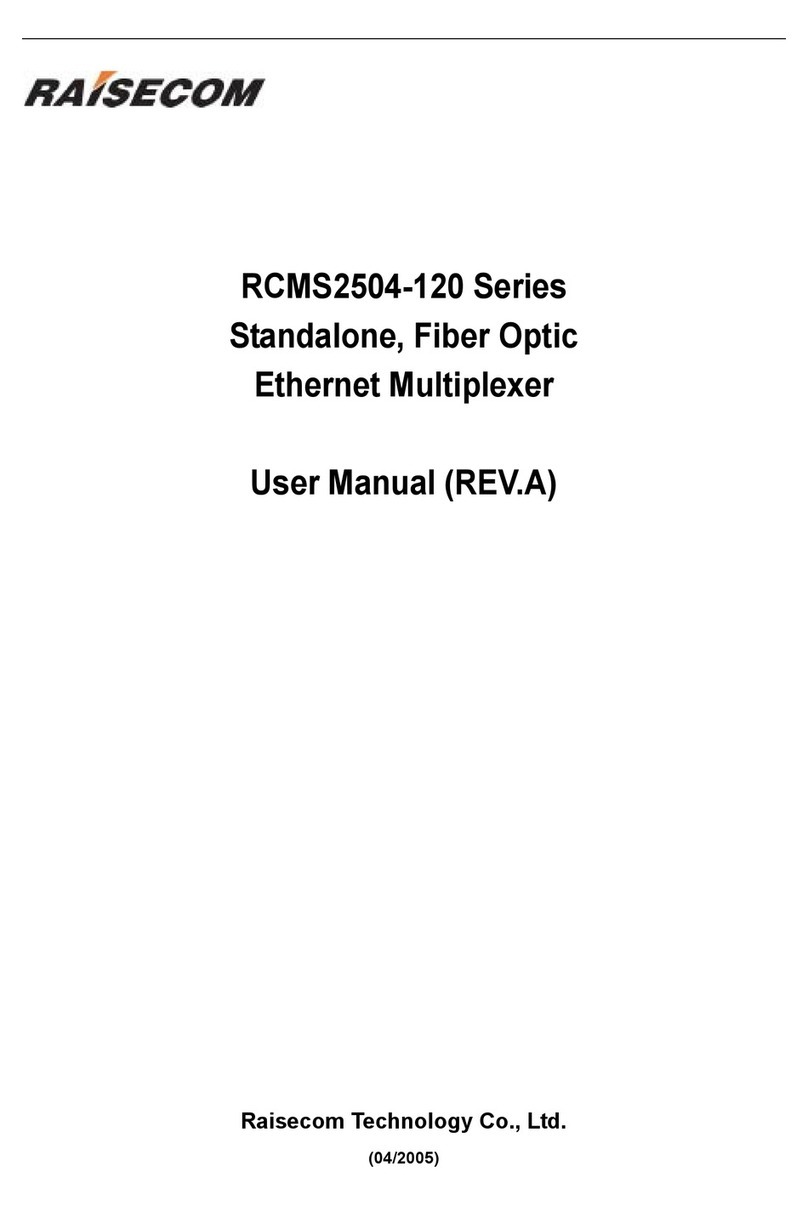
Raisecom
Raisecom RCMS2504-120 user manual

cctv camera pros
cctv camera pros VM-HD16 Specification and user manual
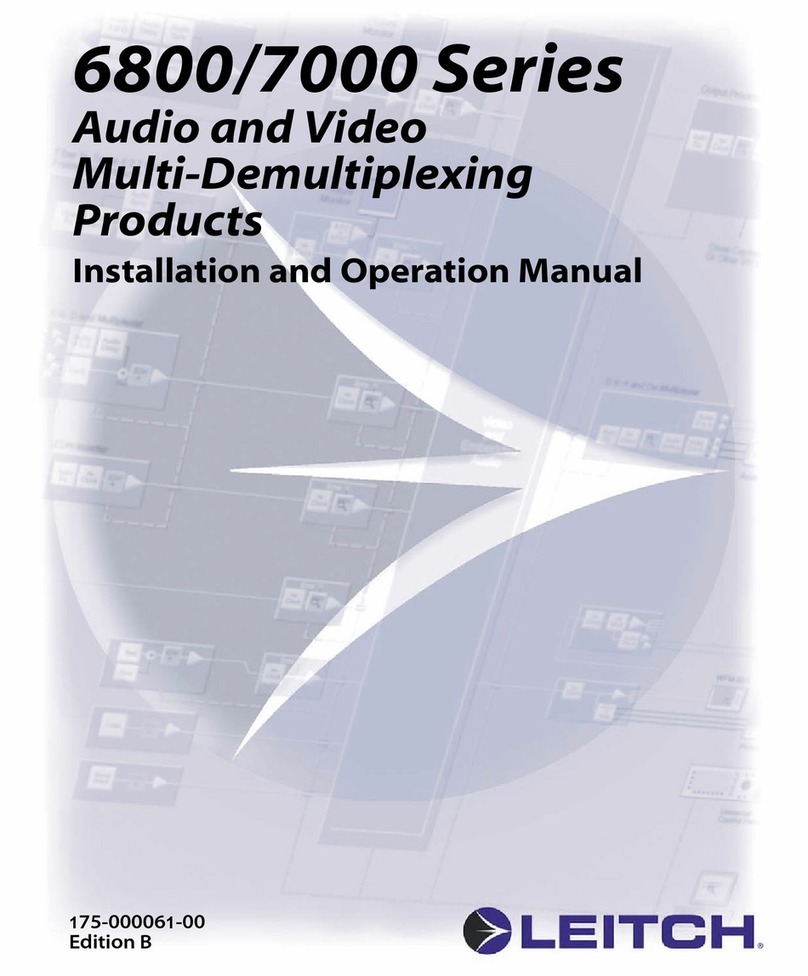
Leitch
Leitch 6800/7000 Series Installation and operation manual
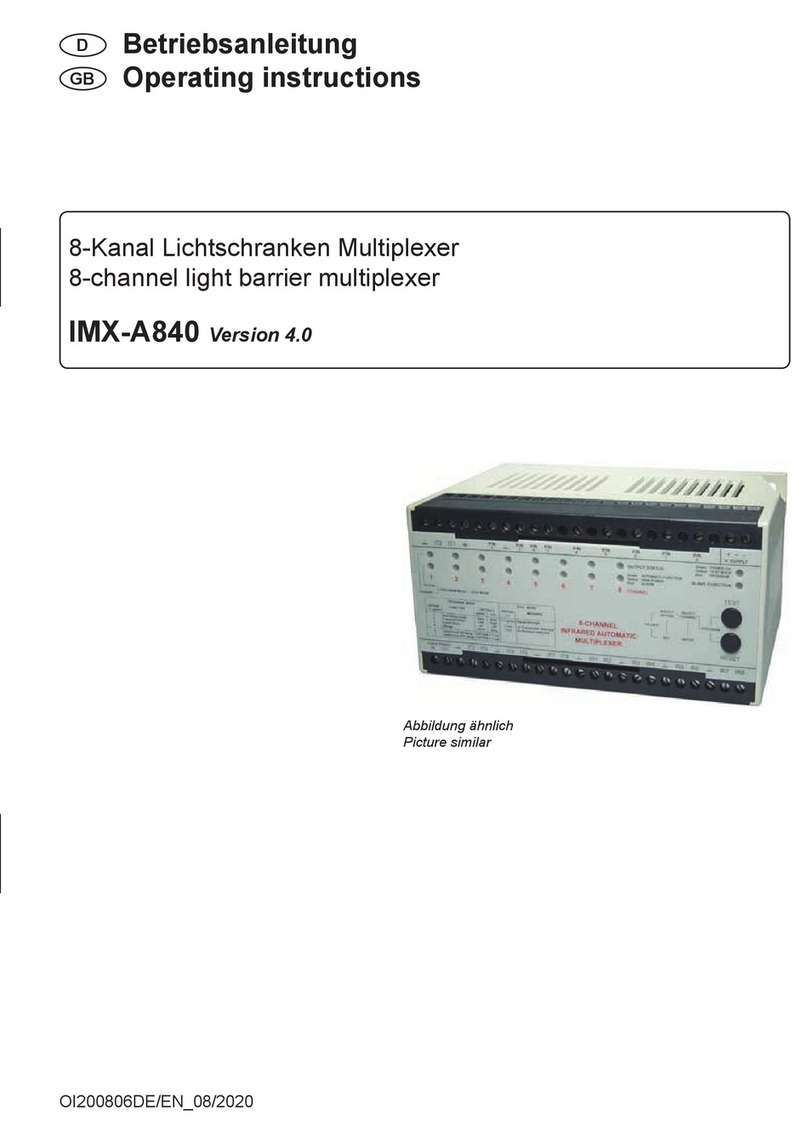
Pantron
Pantron IMX-A840 Series operating instructions
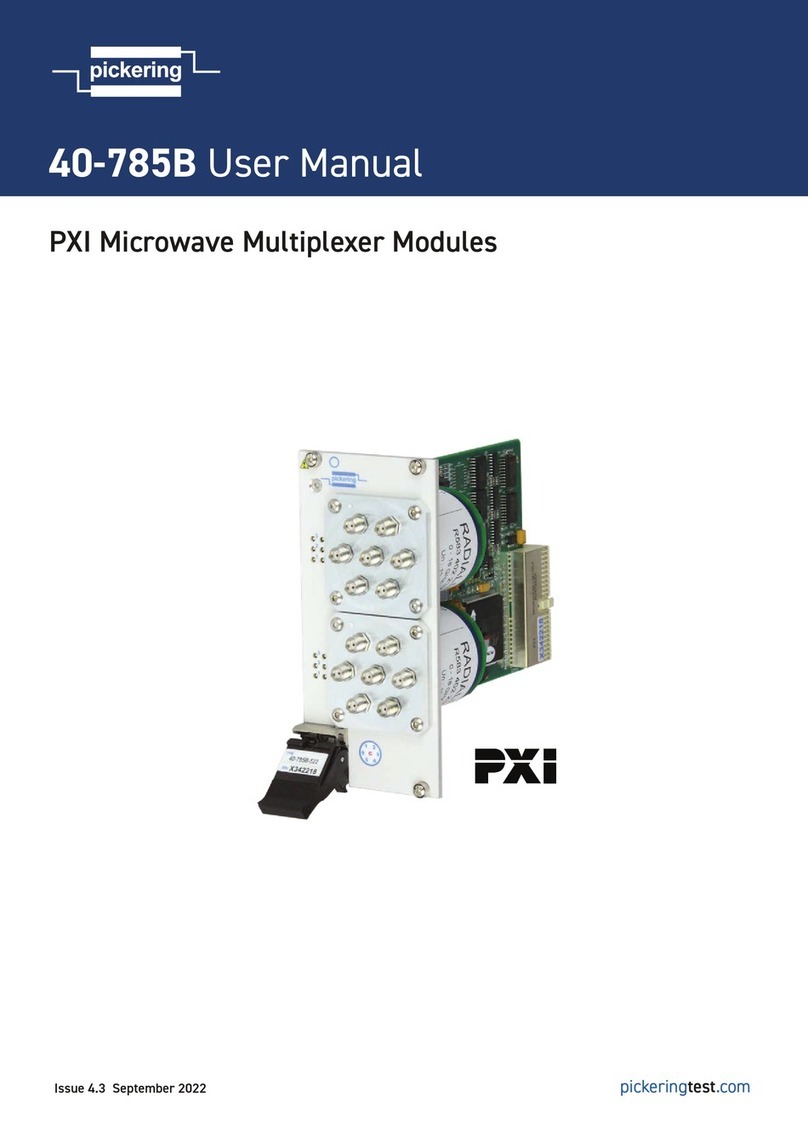
Pickering
Pickering PXI 40-785B user manual

